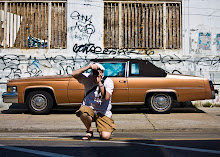Needless to say, this was disappointing to a self-deluded photographer who just wanted to hear that I didn't need to apply to SCAD since my talent was so self-evident. I would be accepted without question. However, after the sting wore off, I realized he made a lot of sense. I certainly had a few themes that I was drawn to--see earlier posts for examples--but had never started with an idea first and then took pictures to embody that idea. I had always worked the other way around, just taking photos of things I responded to viscerally and afterward trying to see a narrative that connected them together.
Over the ensuing years, as I've developed as a photographer and artist, I've been thinking about Ideas and what would make a good series and have come up with a few possibilities. I wanted to take this entry to sketch out one such series. It is still very fuzzy in my head and so would love to get any feedback from you.
Food. I'm fascinated with food. Not only the consumption of it--I love to cook, love to eat--but also the ways in which it gets commodified in our culture. Needless to say, our relationship to food in the United States is different than a society that doesn't have such abundance. Only in an industrialized, rich country, for example, could food literally be a toy.
Food is a complicated commodity though because it's not just a sign of wealth or prestige, but is essential to life. Unlike most consumer items, food is actually consumed. The bare nutritive value of it gets repackaged in a variety of ways though according to social and cultural values. I'm fascinated with how we package and sell this essential item. The various brands of foodstuffs stacked on grocery store shelves have roughly the same nutrient value, no matter what brand. So what stimulates the competition for sales required in a capitalist food culture? Primarily, it's a graphical battle. The artistic design that goes into creating the labels marks the food as creating its value to consumers through how well it calls to the eye on the shelf as a graphical abstraction separate from its nutritive value. In some ways, this is a topic already well explored by the likes of Andy Warhol in his famous Campbell soup can pieces.

However, grocery stores are not the only gathering places for food in our culture. I'm also fascinated with the visual aspect of food when it is presented in restaurants. The visible markers that go into differentiating a fast food lunch at McDonald's--the paper wrappers, paper cups, and colorful cardboard containers--from a fancy dinner at a gourmet bistro--flowers and candles on the table, china, a garnish on the plate. It is a feast for the eye as well as the belly.
I became especially interested in how we interact with the food, as the consumer literally consumes the work of art. My idea was to capture the canvas of the plate *after* the consumer/eater/artist had finished eating. Here are two examples:
Chinese Meal

Mexican Meal

I like these photos because they work abstractly as art with the vibrant colors and swirls and shapes of the emptied plate. However, they also stand as testament to the consumer and the consumed. They represent both the nutritive value of the food as well as its visual impact.
One concern I have about this series is whether it would get too repetitive. Would one emptied plate eventually look just like another emptied plate? However, I think that this would be a problem for any series. If the items are connected through a strong, central, controlling idea, then isn't repetition an inherent danger? Now, I'm aware that this idea for a series isn't fully developed yet, but I remain intrigued by it. What I'm hoping is that you can tell me what you think. Is it worth pursuing? How can I further flesh out the idea behind it? The center pole needs to be strong to keep this tent up. Very curious what people think about this direction for me. If nothing else, I hope I've given you some food for thought. Ha!
RAV
